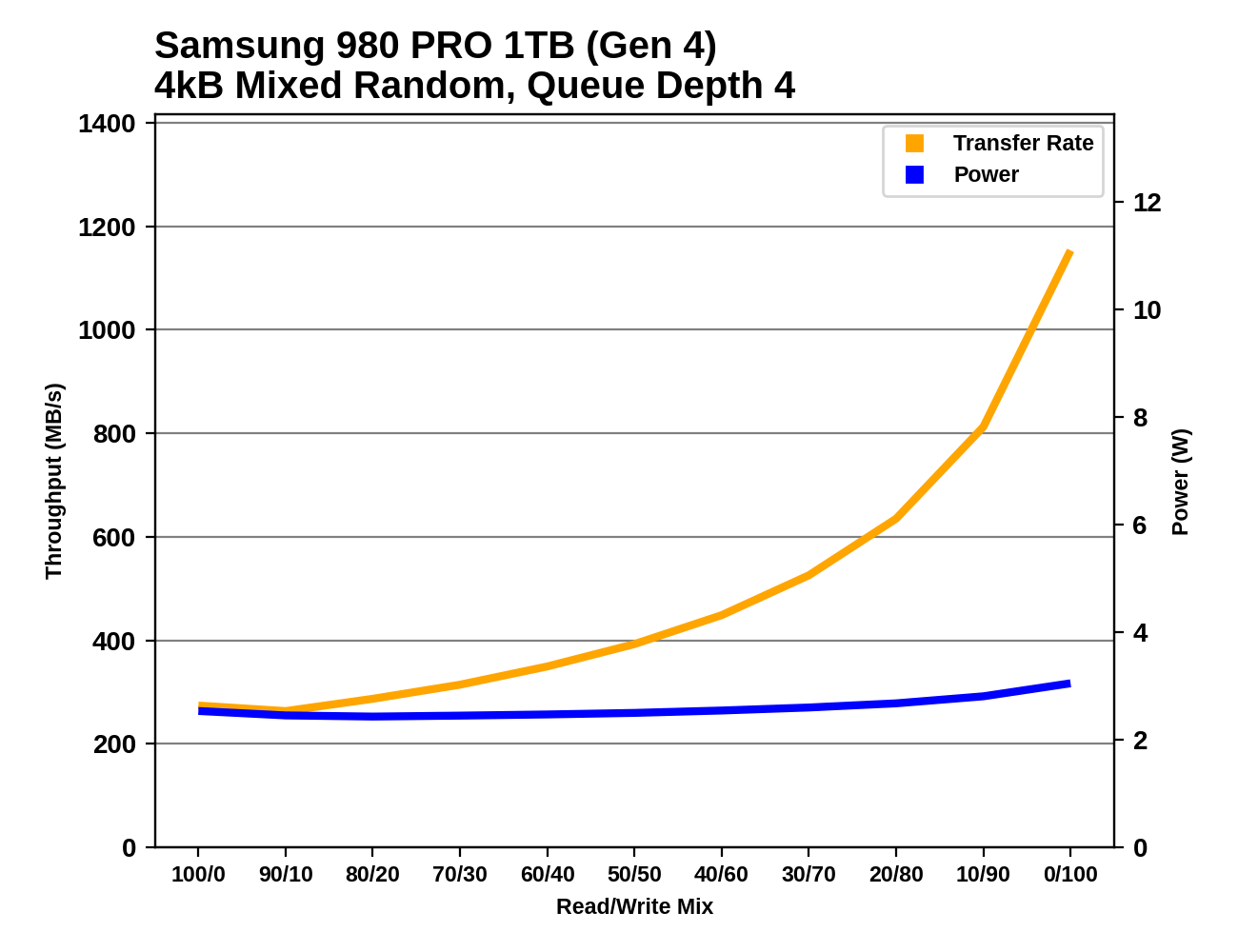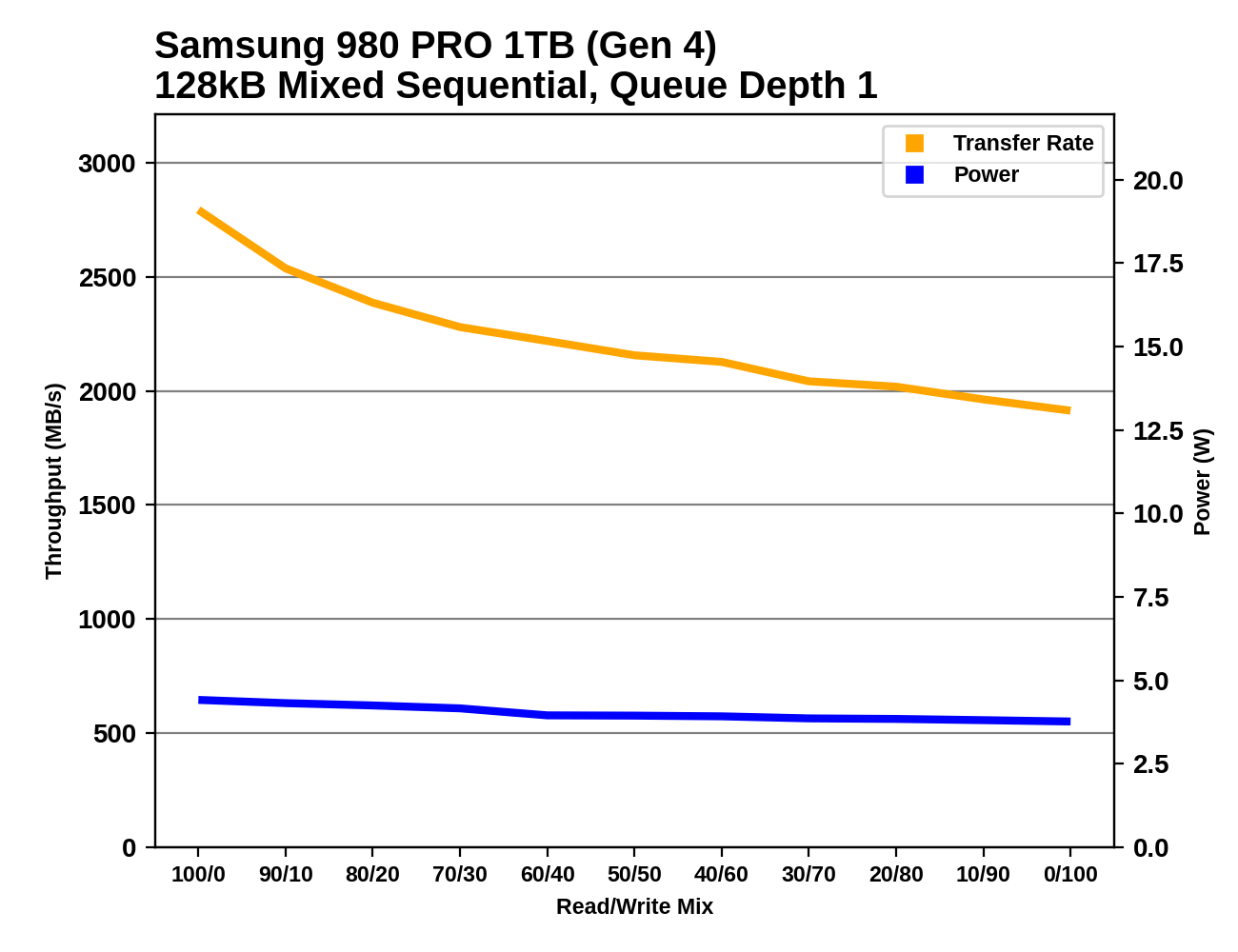The Samsung 980 PRO PCIe 4.0 SSD Review: A Spirit of Hope
by Billy Tallis on September 22, 2020 11:20 AM ESTNote: All our previous testing has been on an Intel test bed. Because of the move to PCIe 4.0, we have upgraded to Ryzen. Devices tested under Ryzen in time for this review are identified in the charts.
Mixed Random Performance
Our test of mixed random reads and writes covers mixes varying from pure reads to pure writes at 10% increments. Each mix is tested for up to 1 minute or 32GB of data transferred. The test is conducted with a queue depth of 4, and is limited to a 64GB span of the drive. In between each mix, the drive is given idle time of up to one minute so that the overall duty cycle is 50%.

Since our mixed random IO test uses a moderate queue depth of 4, the PCIe Gen4 drives don't get much chance to flex their muscle. The overall scores are still generally bound by NAND flash latency, which doesn't vary too widely between current generation drives. There's also a small performance boost when running this test on our newer, faster Ryzen testbed. The Samsung 980 PRO is clearly an improvement over its predecessors, but is merely tied for first place among flash-based drives with the SK hynix Gold P31.
 |
|||||||||
| Power Efficiency in MB/s/W | Average Power in W | ||||||||
Both capacities of the 980 PRO turn in good efficiency scores for the mixed random IO test, substantially improving on Samsung's previously mediocre standing. The 1TB 980 PRO's efficiency is second only to the SK hynix Gold P31. The 980 PROs are a bit more efficient running at PCIe Gen3 speeds than on the Gen4 platform, despite the ~10% performance boost on the faster system.
 |
|||||||||
There are no real surprises in the performance profiles of the 980 PROs. Both capacities show the same general behavior as earlier Samsung drives, albeit with small improvements to performance and power consumption across the board.
Mixed Sequential Performance
Our test of mixed sequential reads and writes differs from the mixed random I/O test by performing 128kB sequential accesses rather than 4kB accesses at random locations, and the sequential test is conducted at queue depth 1. The range of mixes tested is the same, and the timing and limits on data transfers are also the same as above.

The Samsung 980 PROs take the top spots for our mixed sequential IO test, with even the 250GB 980 PRO edging out the 1TB Seagate FireCuda 520. Even when limited to PCIe Gen3, the 980s are a clear step up in performance from eariler high-end drives. The improvement for the 250GB model is the most impressive, since the 250GB 970 EVO Plus is significantly slower than most of the 1TB drives.
 |
|||||||||
| Power Efficiency in MB/s/W | Average Power in W | ||||||||
The 980 PROs turn in more good power efficiency numbers that place them clearly ahead of everything other than the SK hynix Gold P31. And this time, the P31's efficiency lead relatively small at no more than about 25%.
 |
|||||||||
The 980 PROs show a drastically different performance profile compared to earlier Samsung drives. The 970s tend to bottom out during the write-heavy half of the test and recover some performance toward the end. Now with the 980 PRO, performance in the write-heavy half doesn't drop precipitously, so we see a steady decline that most closely resembles how the Intel Optane SSD handles this test










137 Comments
View All Comments
Billy Tallis - Wednesday, September 23, 2020 - link
I don't expect PCIe 4.0 to provide any significant benefit to NVMe HMB operation. But widespread PCIe 4.0 support may eventually lead to low-end NVMe SSDs typically using just two PCIe lanes, and saving a bit more power that way.anad0commenter - Wednesday, September 23, 2020 - link
This is very disappointing. I guess we should expect 980 EVO to be QLC based next year.kevin.mcc - Wednesday, September 23, 2020 - link
This late in the game and being a "PRO" product, there are the 2TB and 4TB drives? Are people that are looking at the "PRO" line really that interested in sub-1TB drives these days? Especially 250GB drives?XabanakFanatik - Wednesday, September 23, 2020 - link
Nope. Nobody looking at the PRO drives was interested in TLC, either. The entire product is crap.FXi - Wednesday, September 23, 2020 - link
These things run hot. Be very careful what devices you put them into.Billy Tallis - Wednesday, September 23, 2020 - link
These drives generally put out less heat than Samsung's previous generation of NVMe SSDs, except in a few circumstances where the performance is much higher—and even then, they put out less thermal energy for the same amount of work.fred666 - Wednesday, September 23, 2020 - link
So in short there is basically very little benefit in moving from PCIe 3 to 4, even with this high end drive.Would have been interesting to see also a PCIe 2 x4 (or PCIe 3 x2) for comparison.
Billy Tallis - Wednesday, September 23, 2020 - link
I do have a handful of results from the Samsung XP941 in Bench: https://www.anandtech.com/bench/product/2227?vs=26...That's a PCIe 2.0 drive, but uses AHCI instead of NVMe.
Luckz - Thursday, September 24, 2020 - link
The type of NAND (and how it's accessed: using NVMe instead of AHCI) is more relevant than the connection itself.PCIe 3 is just one potential bottleneck. As you can read in the article multiple times, you'd really want multiple CPU cores and separated I/O queues to fully benefit from the increased bandwidth of PCIe 4.
Beaver M. - Wednesday, September 23, 2020 - link
Good price. I rather buy this than a comparable EVO.Are they trying to change their branding or why is that?
We might see a 980 "Ultra" and EVOs all getting QLC instead.